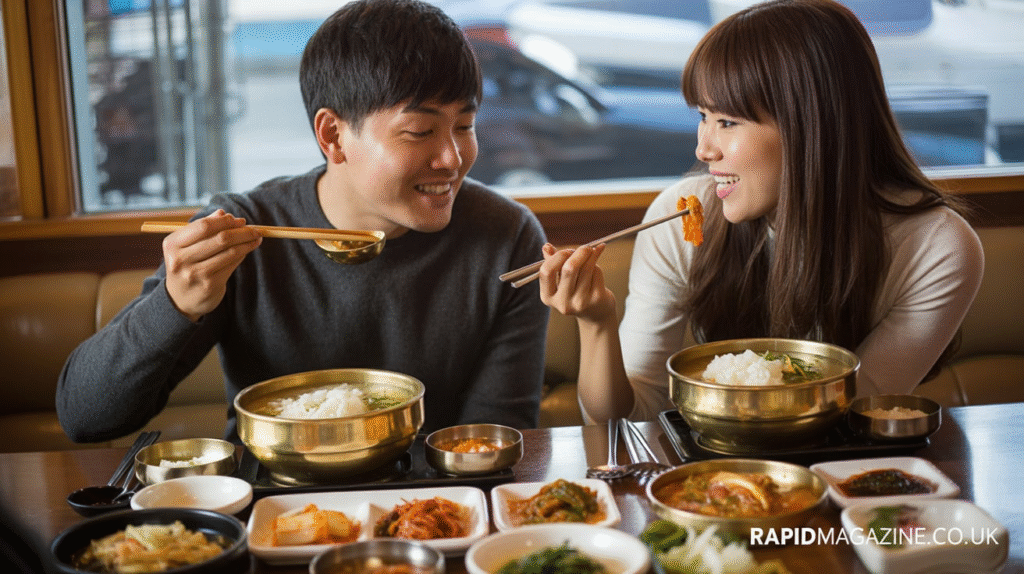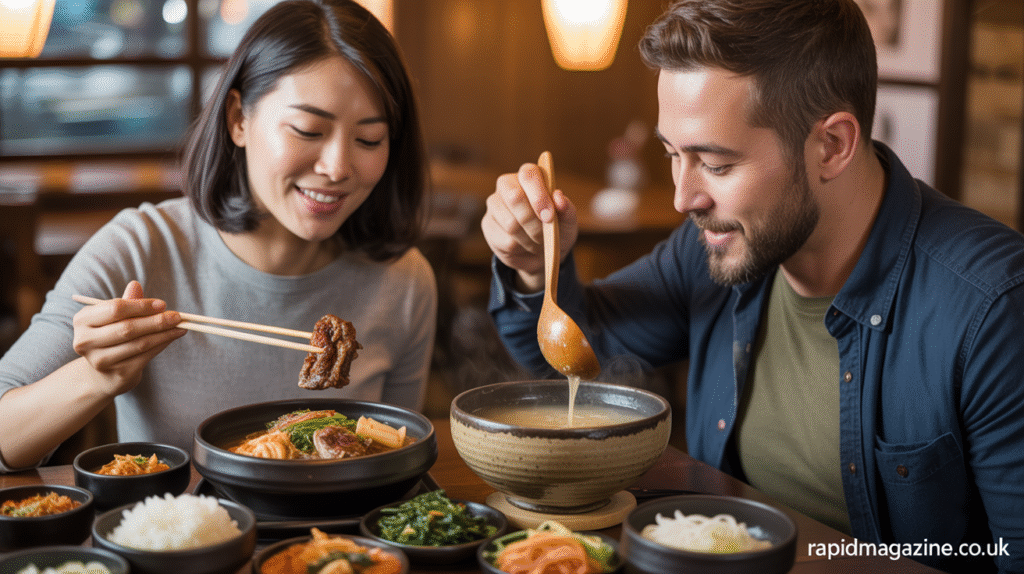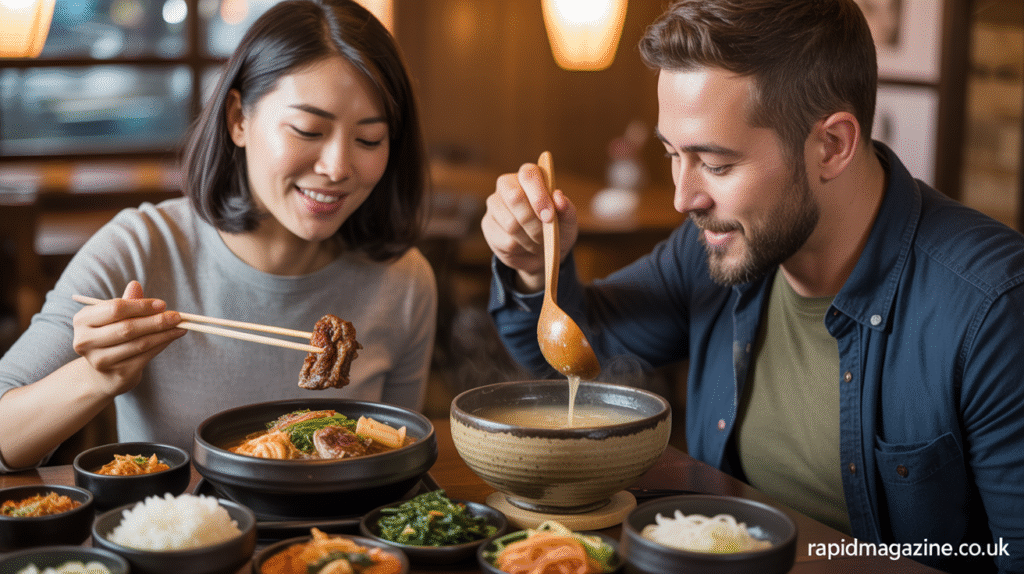If you love warm, cozy foods that bring comfort on cold days, you’ll want to know about gommeok. This dish is not only delicious but also full of history, culture, and health benefits. In Korea, gommeok is more than just a soup. It is a tradition, a healing food, and a family favorite. Many Koreans enjoy it when they need strength, comfort, or simply a tasty meal that feels like a hug in a bowl. In this article, we’ll dive deep into the world of gommeok. You’ll learn what it is, how it’s made, its health benefits, and even how to enjoy it at home.
What Is Gommeok?

Gommeok is a traditional Korean soup made by simmering beef bones, meat, and other ingredients for an extended period of time. Slow cooking creates a rich, milky broth filled with flavor and nutrients. Koreans often drink it plain or with rice and side dishes. It’s not just food—it’s comfort. For generations, families have gathered around bowls of steaming gommeok, especially in winter. The word itself reflects warmth and nourishment. Unlike quick meals, gommeok takes time and care, which is why it’s often connected with love and family tradition.
A Brief History of Gommeok
The history of gommeok goes back centuries. In old Korea, families would save beef bones after special occasions. Instead of throwing them away, they boiled them slowly to make a hearty soup. This practice ensured nothing went to waste. Over time, gommeok became a symbol of resourcefulness and care. Kings and nobles also appreciated it due to its rich flavor and health benefits. Today, you can find gommeok everywhere—from family kitchens to Korean restaurants around the world. Its history connects modern eaters with the past, making each sip a taste of tradition.
Why Gommeok Is So Special
So, what makes gommeok different from other soups? The answer lies in its depth of flavor. The broth is cooked for hours, sometimes even overnight, until the bones release all their nutrients. This process gives gommeok its famous creamy white color. It is both light and filling at the same time. People love it because it feels nourishing, almost like medicine. Parents often serve it to children when they are sick. Elders enjoy it for strength, while busy workers find comfort in it after long days. It’s simple, but incredibly meaningful.
How Gommeok Is Traditionally Made

Cooking gommeok the traditional way requires patience. First, beef bones are cleaned and soaked to remove impurities. Then they are simmered for hours, often 12 hours or more, until the broth turns milky white. Meat, garlic, onions, and sometimes radish are added for flavor. The soup is not heavily seasoned during the cooking process. Instead, people season their own bowls with salt, pepper, or green onions as they are served. This lets each person adjust the flavor to their own taste. The result is a soothing, flavorful broth that pairs beautifully with rice and kimchi.
Modern Variations of Gommeok
While the traditional recipe remains popular, many modern versions of gommeok have emerged. Some cooks add noodles for a heartier meal. Others use different meats or vegetables for unique flavors. Instant gommeok is even available in grocery stores. Now busy families can enjoy this comfort food in less time. Restaurants sometimes serve gommeok with dumplings, seafood, or spicy toppings to appeal to younger diners. These changes keep the dish alive and exciting while honoring its traditional roots.
Health Benefits of Gommeok
One reason gommeok has stayed popular for centuries is its health value. The long-simmered broth is rich in minerals, such as calcium and magnesium, which are derived from the bones. It also contains collagen, which is good for joint and skin health. The warm broth soothes the stomach and helps with digestion. Many people believe gommeok helps restore energy after illness or fatigue. In fact, it is often served to women after childbirth in Korea. This makes it more than food—it is a healing dish passed down through generations.
Gommeok in Korean Culture

In Korea, gommeok is deeply rooted in family and tradition. It’s often served during holidays, family gatherings, or after important events. Sharing a big pot of gommeok at the table creates a sense of togetherness. It’s also common to see restaurants open 24/7 that serve gommeok, especially near busy city centers. These places attract late-night workers, students, and anyone craving a comforting bowl. For many Koreans, gommeok represents care, healing, and a sense of home. It’s not unusual for someone living abroad to crave gommeok as a reminder of family and culture.
How to Enjoy Gommeok at Home
Want to try gommeok at home? The good news is, you don’t have to be a professional chef. All you need is beef bones, water, and patience. Simmer the bones for several hours until the broth becomes rich and creamy. Add simple seasonings like garlic, onions, and green onions. Serve with rice, kimchi, or your favorite Korean side dishes. If you want a shortcut, look for pre-made gommeok broth in Asian grocery stores. You can then add meat, noodles, or vegetables to make it your own. It’s a fun way to enjoy authentic Korean comfort food.
Where to Find Gommeok Around the World
Thanks to the spread of Korean culture, gommeok is no longer limited to Korea. Korean restaurants worldwide often feature it on their menus. You can find it in cities like Los Angeles, New York, London, and Sydney. Many Korean grocery stores also sell packaged broth or instant gommeok for convenience. Online shops even ship it directly to your home. This global availability makes it easy for anyone curious about Korean cuisine to try it. No matter where you live, a taste of gommeok is within reach.
Gommeok vs. Other Korean Soups
Korea is well known for its soups and stews, yet gommeok is unique among them. Unlike spicy soups like kimchi jjigae, gommeok is mild and soothing. Unlike doenjang jjigae, which uses soybean paste, gommeok relies on bone broth for its flavor. It is closest to seolleongtang, another milky beef soup, but gommeok usually has a richer flavor from longer cooking. Each soup has its own charm, but gommeok is often the go-to when comfort and healing are needed. This makes it a unique part of the Korean culinary tradition.
Personal Experience with Gommeok
The first time I tried gommeok, it was in a small Korean restaurant on a rainy night. The steam from the bowl warmed my face, and the first sip felt soothing and rich. I noticed how the broth wasn’t spicy or strong, but simple and comforting. It reminded me of the chicken soup I had as a child when sick. The restaurant served it with rice and kimchi, and I remember finishing everything. That meal left me with a deep respect for this humble soup. Since then, I’ve made gommeok at home many times.
FAQs About Gommeok
1. What does gommeok taste like?
Gommeok has a mild, savory, and slightly creamy flavor. It is not spicy. The broth tastes rich but light, making it easy to enjoy.
2. Is gommeok the same as seolleongtang?
They are very similar, but not identical. Both are beef bone soups, but gommeok often has a deeper, richer flavor from longer simmering.
3. How long does gommeok take to cook?
Traditionally, it takes 12 hours or more to get the creamy broth. However, modern pressure cookers can significantly reduce the cooking time.
4. Can vegetarians eat gommeok?
The traditional version uses beef bones, making it unsuitable for vegetarians. However, some modern recipes use mushrooms, soy, or vegetable broth as a substitute.
5. Is gommeok healthy?
Yes, gommeok is considered a very healthy option. It is rich in minerals, protein, and collagen. It also helps with digestion and energy recovery.
6. Where can I buy gommeok broth?
You can pick it up at Korean grocery stores, Asian markets, or order it from online shops. Some restaurants also sell frozen broth for take-home meals.
Conclusion: Why You Should Try Gommeok
Gommeok is more than just a soup. It’s comfort, healing, and tradition in one bowl. Whether you try it at a restaurant or cook it at home, gommeok offers a taste of Korean culture and care. Its rich broth, simple ingredients, and deep history make it special. If you’re looking for a dish that warms the body and heart, gommeok is the answer. Give it a try, share it with loved ones, and experience why Koreans have cherished this soup for centuries.








